Book contents
- Frontmatter
- Dedication
- Contents
- Acknowledgments
- Editor's Introduction
- List of contributors
- I ANTIQUITY
- II THE MIDDLE AGES
- 8 Sufism
- 9 Kabbalah
- 10 Medieval Christian Mysticism
- 11 Hildegard of Bingen and Women's Mysticism
- III THE RENAISSANCE AND EARLY MODERNITY
- IV THE NINETEENTH CENTURY AND BEYOND
- V COMMON THREADS
- Suggestions for Further Reading
- Index
- References
8 - Sufism
from II - THE MIDDLE AGES
Published online by Cambridge University Press: 05 May 2016
- Frontmatter
- Dedication
- Contents
- Acknowledgments
- Editor's Introduction
- List of contributors
- I ANTIQUITY
- II THE MIDDLE AGES
- 8 Sufism
- 9 Kabbalah
- 10 Medieval Christian Mysticism
- 11 Hildegard of Bingen and Women's Mysticism
- III THE RENAISSANCE AND EARLY MODERNITY
- IV THE NINETEENTH CENTURY AND BEYOND
- V COMMON THREADS
- Suggestions for Further Reading
- Index
- References
Summary
Introduction
The Arabic word ṣūfī, the original sense of which has been much discussed, came into use in the second century AH/eighth century CE to designate a certain sort of pious, usually ascetic, individual. Its derivative form “Sufism” (taṣawwuf, literally, “to be a ṣūfī”) has been one of several terms used to designate those tendencies of Islamic thought and practice that focus on the inner domain of the human spirit rather than the outer domain of ritual activity, social rules, and creedal dogmatics. Many Western scholars have referred to Sufism as mysticism, esotericism, or spirituality, but there is no consensus as to what exactly it, or any of these words, designates. The difficulty of defining the word “Sufism” itself is partly the result of the historical and geographical vagaries of the word's usage and the frequent controversies over its legitimacy – controversies in which the two sides typically had radically different notions of what it denotes. Throughout Islamic history, numerous definitions have been offered by authors claiming to speak for it. These are rarely consistent with the notion that Sufism had a clearly defined identity, especially when we take into account the definitions offered by critics. In what follows, I use the word as a designation for the focus on “interiority” that is found in the sources of the Islamic tradition and in countless authors down through the centuries, whether or not the term “Sufism” itself was employed in each case. I will discuss three broad issues: Sufism's relation to other fields of learning, its characteristic approach to theory, and its understanding of the role of praxis.
The Three Dimensions of Islam
The Koran and the Hadith (the sayings of Muhammad) are full of raw material for the disciplines that came to be called jurisprudence (fiqh), scholastic theology (kalām), philosophy, and Sufism, but these disciplines themselves appeared gradually. When scholars say that Sufism originated in the second/eighth or third/ninth centuries, they mean that before that time, the sources do not delineate the specific concerns that differentiate the Sufis of later times from other Muslims. The same is true, however, for the other approaches to Islamic thought and practice – not least jurisprudence and scholastic theology, which are often said to represent “orthodox” Islam.
- Type
- Chapter
- Information
- Publisher: Cambridge University PressPrint publication year: 2016



